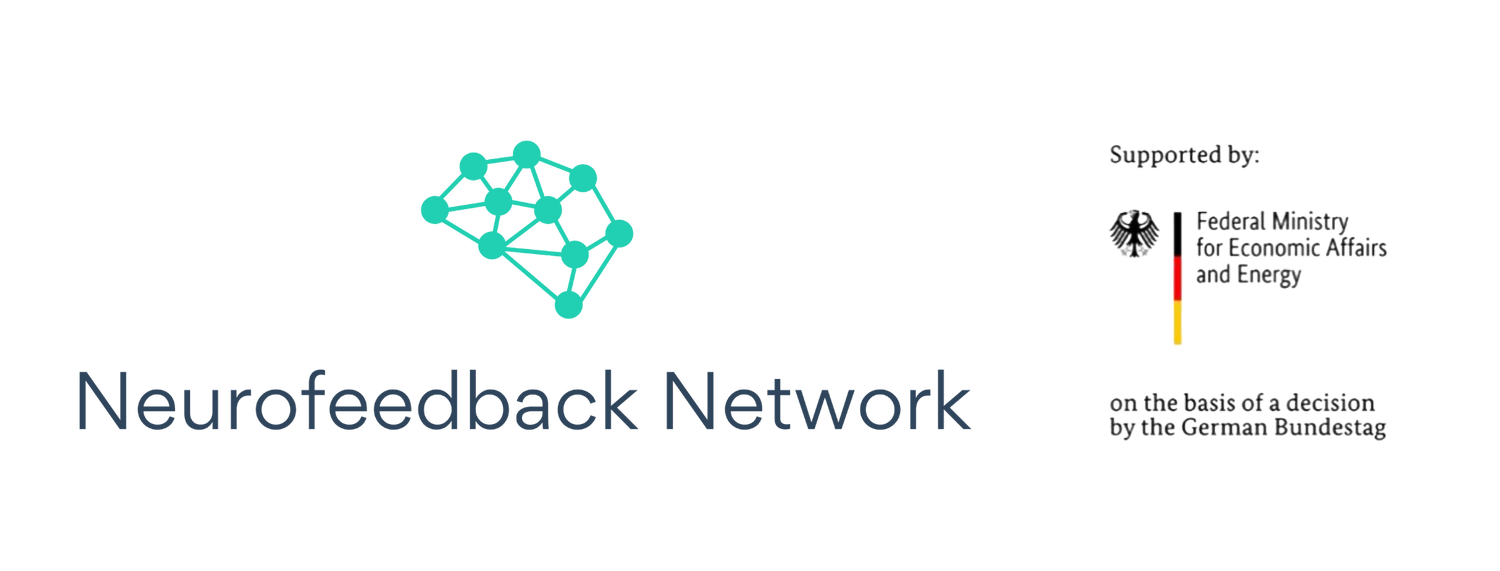
How does a Neurofeedback session work?
1. Attaching the electrodes
Neurofeedback is based on measuring the electrical activity of the brain. Therefore electrodes are placed on the patient’s head at the beginning of the session in order to be able to derive the EEG signals. The application of the electrodes, like the entire treatment, is absolutely painless when used properly by a trained doctor or therapist. Any residues of conductive pastes that are necessary to attach the electrodes can be easily removed from the hair after the treatment.
2. Derivation of EEG signals
The EEG signals measured via the electrodes are directly transmitted to a computer via a special amplifier. Using software, the EEG signals are evaluated and broken down into their individual wavebands and frequency bands. This allows the individual characteristics of brain activity to be made visible and used to improve the brain’s ability to regulate itself.
3. Visualization of brain activity
The visualization of the wavebands and the individual frequency bands is now carried out through two monitors. The therapist follows the spontaneous EEG on a screen, broken down into the individual wavebands.
At the same time, the patient sees an age-specific graphic on his own monitor – this can be an animation, a computer game or a short film – which also moves according to brain activity.
If the desired change – depending on the intensification or reduction of certain activity patterns – is achieved, the patient receives direct feedback via the monitor. Thus, the animation moves towards a target or the image becomes clearer and sharper. An acoustic signal usually supplements this feedback. Thus, a positive reinforcement of the desired behavior takes place.
How long does a Neurofeedback session last?
Including all necessary preparations, a session lasts approximately 45 to 60 minutes.
Treatment with Neurofeedback must be done at regular intervals, usually once or twice a week. In the advanced course of therapy, the intervals between the individual sessions can also be extended. However, it is also important to differentiate between different areas of application and to adapt the therapy to the individual needs of the patient.
Can Neurofeedback be used alongside other procedures or during medication?
Note: This information is valid for Germany.
Neurofeedback can basically be used alongside other procedures and also during medication. In this context, please also note the information given under the point “Is Neurofeedback suitable for everyone?”
Since neurologically related diseases are very complex and need to be treated comprehensively, Neurofeedback is usually part of multimodal therapy and is used in addition to other interventions such as behavioral therapy or drug therapy. Treatment with Neurofeedback also (in most cases) aims to supplement medication and reduce drug doses. Treatment with Neurofeedback must, in any case, be preceded by a guide-line based diagnosis and a thorough anamnesis. A trained doctor or therapist with appropriate experience will adapt the therapy to the individual needs of the patient.
Is Neurofeedback suitable for everyone?
Basically, Neurofeedback is not tied to any particular requirements on the part of the patient. In any case, however, please inform your doctor or therapist about previous illnesses, your state of health and any medication you are taking.
Basically, Neurofeedback can be used from primary school age to old age. The treatment is not tied to any specific requirements, but you should always inform your doctor or therapist about current or chronic complaints, previous illnesses, or pregnancy. You should also talk to them about your general state of health and your current life situation. For example, are you under pressure to perform or do you often have headaches? A good Neurofeedback therapist will also inquire about your state of health before starting therapy.
What is the cost of a Neurofeedback session?
The amount charged per session depends on the fee schedule to which the treating therapist is bound. Prices range from €60 to €140 per session, depending on the type of session. The total cost also depends on how many sessions are needed. In some cases, 20 sessions are sufficient. In other cases, the number of sessions may be much higher. The cost can therefore vary considerably in some cases.
Is there a possibility of cost reimbursement by the health insurance company?
Neurofeedback is known as an "IGeL" (Individual Health Service) and is therefore billed as a private medical service. However, reimbursement by the statutory health insurance may be possible in individual cases. In any case, it is worth informing the health insurance company in advance. Private health insurance plans and tariffs also vary widely, so it is worth contacting them in advance.
Neurofeedback in occupational therapy and behavioral therapy – costs can be covered with appropriate prescription
Neurofeedback is not listed as a stand-alone remedy in the Remedies Guidelines. However, if there is a medical indication, Neurofeedback can be used as a technique within the available occupational therapy remedies.
As part of behavioural therapy, neurofeedback can be provided by a trained behavioural therapist who is approved by the health insurance companies. The treating therapist must inform you that neurofeedback is part of the therapy and therefore, exceptionally, not an IGeL.
Is Neurofeedback suitable for home use?
Neurofeedback systems are medical devices that should only be in the hands of a medical professional - a trained doctor or therapist who has completed appropriate training. The Neurofeedback Network therefore dissociates itself from those who recommend or promote home use. Rather, our network is working to further establish neurofeedback as a medical application.
There are several reasons against home use: Firstly, home treatment cannot guarantee that the correct settings are being used, that the electrodes are being applied correctly, or that EEG signals or only artefacts are being measured during treatment. On the other hand, neurofeedback is a treatment that is largely free of side effects. In rare cases, however, side effects such as headaches, nausea or rapid heartbeat can occur. This is called inappropriate adaptation. These effects are usually of very short duration and are controlled by the therapy - unless the incorrect training is continued for a longer period of time. Incorrect exercise can make symptoms worse rather than better. Therefore, it should only be carried out by appropriately trained neurofeedback professionals who can adjust training protocols in the event of side effects.
Neurofeedback is a form of therapy that must be tailored to the individual patient. Therefore, neurofeedback should not be used without the specific expertise, neuropsychological and neurophysiological knowledge of an expert.
Important note:
The information on this page is not intended to be a substitute for professional advise or treatment by trained and recognized doctors and therapists. The content of this page may not be used to independently diagnose or start treatment.






